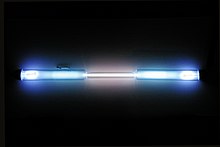Krypton
Krypton is a stable noble gas. It has an atomic number of 36. The name krypton comes from the Greek word kryptos meaning hidden. It is used in fluorescent lamps, flashbulbs, and as a wavelength standard. The metre used to be defined as 1,650,763.73 wavelengths in a vacuum of krypton gas.[1]

Chemistry
Because it is a gas, it does not react with many elements. It is clear and has no taste or smell.[2] The atmosphere is only about one millionth part krypton.[2] Krypton has very few compounds.
Uses
The main use for krypton is to make light. There is one main type of krypton light bulbs. This is called a gas discharge lamp. There are three main types of these. First is a low energy gas discharge lamp or "neon light". Low energy gas discharge lights made from krypton are near white to green. Second is a high energy short length of time gas discharge light or "flash bulb". These are mostly used for photography. They are bright blue-white. Third is a high energy gas discharge light. This third kind is mostly used to light airport runways. They are also bright blue-white.
History
Krypton was found by Sir William Ramsay and Morris Travers in Great Britain in 1898.[3] Ramsay was given the 1904 Nobel Prize in Chemistry for his work on noble gases.[4] It was a difficult gas to discover; Ramsay suspected it existed but only found it by removing other gases.[5] This is why he gave it the name Krypton.[5] There is no mineral called Kryptonite or planet called Krypton, which both feature in the Superman comics by Jerry Siegel and Joe Shuster.[5] The fictional planet is probably better known than the real chemical element called Krypton.[5]
